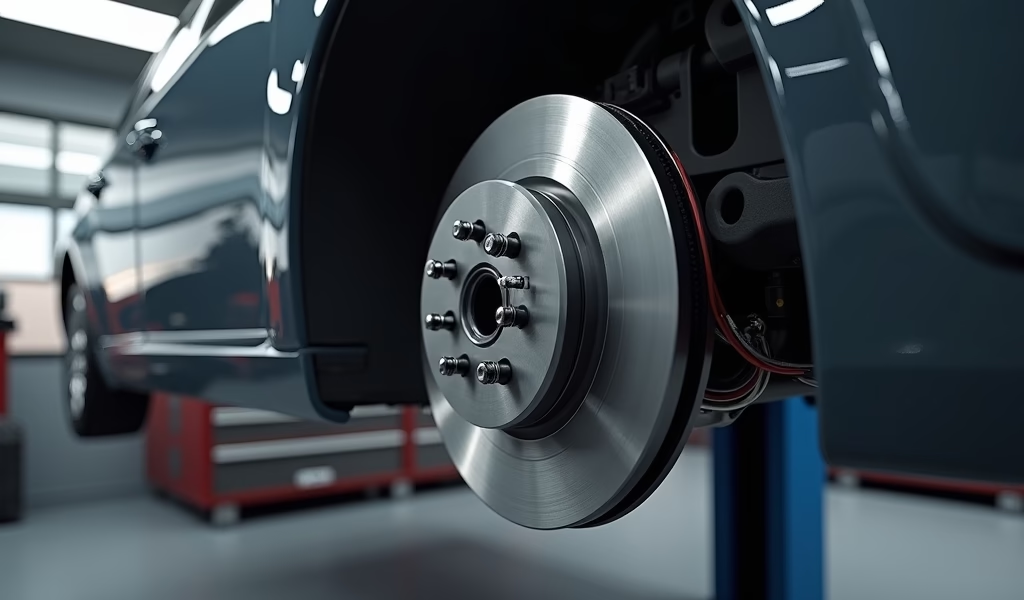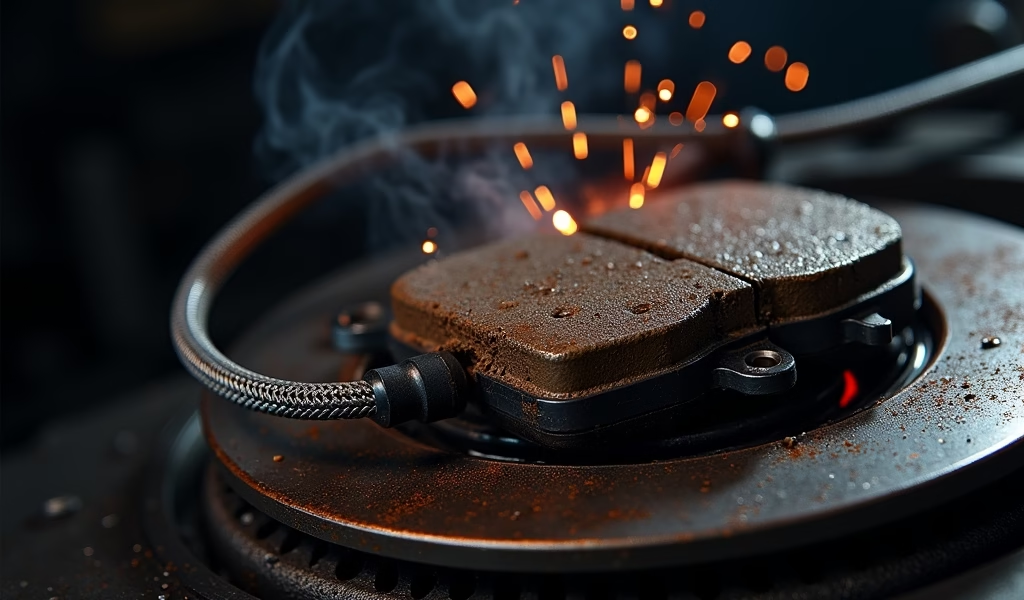Overview
Brake pad wear sensors act as early warning systems that alert drivers when brake pads have worn down to about 25% of their remaining material, typically giving 500-1,000 miles of safe driving before critical replacement is needed. These sensors come in electronic (triggering dashboard lights) and mechanical (creating squealing sounds) varieties, require replacement alongside brake pads, and should never be disconnected when activated as they provide crucial safety information about your vehicle’s braking system.
Table of Contents
- Understanding Brake Pad Wear Sensors: What Are They?
- How Brake Pad Wear Sensors Actually Work
- When Do Wear Sensors Start Alerting You?
- Proper Inspection and Maintenance Tips
- Troubleshooting False Warning Lights
- Sensor Replacement: When and How
- Conclusion
- Frequently Asked Questions
Understanding Brake Pad Wear Sensors: What Are They?
Your car’s braking system is like a loyal watchdog, silently working behind the scenes to keep you safe. At the heart of this crucial safety network sits the humble brake pad wear sensor—a small component that’s worth its weight in gold when it comes to preventing expensive repairs and potentially dangerous situations.
As a mechanic who’s seen countless avoidable brake disasters, I can tell you that understanding brake pad wear sensor operation is one of the smartest moves any driver can make. These tiny sentinels act as your early warning system, letting you know when your brake pads have worn down to a point where replacement isn’t just recommended—it’s necessary.
Brake pad wear sensors are simple electrical devices that activate when your brake pads reach a predetermined minimum thickness. Think of them as the canary in the coal mine for your braking system—they’ll sing out (or light up your dashboard) well before metal-to-metal contact occurs.
In my 20+ years working under cars, I’ve noticed that drivers who understand these sensors tend to avoid the most costly brake repairs. Let’s dig into the five most important things every driver should know about these underappreciated components.
How Brake Pad Wear Sensors Actually Work
Brake pad wear sensors might seem complicated, but they’re actually brilliantly simple in their design. Most modern vehicles use one of two types of sensors, and knowing the difference helps you understand what’s happening when warnings appear.
Electronic Sensors
Most newer vehicles use electronic sensors, which consist of a simple electrical wire loop embedded near the bottom of the brake pad material. These sensors work on a straightforward principle: when your brake pad material wears down to a critical point, the loop makes contact with the brake rotor.
This contact completes an electrical circuit, triggering your dashboard warning light. It’s essentially like flipping a switch that tells your car’s computer, “Hey, these pads are getting dangerously thin!” The beauty is in the simplicity—no batteries or complex electronics required.
Mechanical Sensors
Some vehicles (particularly older models) use mechanical sensors instead. These consist of a small metal tab attached to the brake pad. When the pad material wears down sufficiently, this tab contacts the rotor during braking, creating that unmistakable high-pitched squeal that makes everyone at the stoplight look around.
This noise isn’t a malfunction—it’s actually an intentional design feature meant to alert you audibly rather than visually. Think of it as your brakes literally screaming for attention!
The placement of these sensors is strategic too. They’re typically installed on the brake pad backing plate at a precise distance from the friction surface to ensure they only activate when truly needed. Some high-end vehicles even have multiple sensors per wheel to provide more accurate wear detection.

When Do Wear Sensors Start Alerting You?
Timing is everything when it comes to brake maintenance, and thankfully, wear sensors are designed to give you plenty of advance notice. Most systems are calibrated to activate when approximately 25% of your brake pad material remains—typically when you have about 3-4mm of pad thickness left.
This isn’t arbitrary—engineers have carefully calculated this threshold to provide adequate warning time without being overly sensitive. The goal is to alert you before any damage occurs but not so early that you’re replacing perfectly good brake pads.
That said, the activation point varies between vehicle manufacturers. Luxury brands like BMW, Mercedes-Benz, and Audi often set their sensors to trigger earlier (around 4-5mm), while some domestic vehicles might wait until pads are thinner (2-3mm). According to NHTSA safety guidelines, brake pads should never wear below 2mm of material.
When that dashboard light illuminates, you typically have between 500-1,000 miles of safe driving before the situation becomes critical. This buffer zone is intentional—it gives you time to schedule service at your convenience rather than creating an emergency situation.
In my shop, I’ve noticed drivers often misinterpret the brake wear warning light as meaning “brakes failed” or “stop driving immediately.” While you shouldn’t ignore it, this light is more like a friendly tap on the shoulder saying, “Hey, schedule service soon,” rather than a four-alarm fire.
Proper Inspection and Maintenance Tips
While wear sensors provide automated alerts, there’s simply no substitute for regular visual inspections. Here’s my recommended approach for keeping tabs on both your brake pads and their sensors:
- Inspect your brakes visually at least every 10,000 miles or during tire rotations
- Look for frayed wiring around brake components
- Check that sensor clips remain firmly attached
- Note any unusual corrosion on sensor contact points
- Listen for intermittent squealing that could indicate a sensor making initial contact
A quick inspection takes just minutes but can save you hundreds in potential repair costs. When examining your brake pads, you’re looking for at least 4mm of friction material (about the thickness of two stacked nickels). Any less than that, and you’re approaching the territory where sensors will activate.
For the mechanically inclined, here’s a pro tip: when replacing brake pads yourself, take extra care with the sensor wiring. I can’t tell you how many times I’ve seen DIYers accidentally damage these delicate wires during pad replacement, leading to false warnings or no warnings at all. Handle them gently and route them exactly as they were originally positioned.
If you’re not comfortable doing your own inspections, most repair shops offer free or low-cost brake inspections. As Consumer Reports suggests, these inspections are worth doing at least annually, even if your warning light hasn’t illuminated.
Troubleshooting False Warning Lights
Even the most reliable warning systems sometimes cry wolf. False brake pad wear warnings typically stem from a handful of common issues that are relatively easy to address.
In my experience, the most common culprit behind false warnings is simple electrical connection problems. Road salt, grime, and moisture can create corrosion on sensor connectors, causing intermittent contact that triggers warnings even when your pads have plenty of life left. Cleaning these connections with proper electrical contact cleaner often resolves the issue.
Another frequent cause is damaged wiring. Brake components live in a harsh environment—they endure extreme heat, moisture, road debris, and constant vibration. Over time, this can wear through wire insulation or break connections internally. Check for any visible damage to wiring, particularly where it routes near moving suspension components.
If you’re experiencing persistent false warnings, here’s a step-by-step troubleshooting approach:
- First, verify your actual brake pad thickness to rule out genuine wear issues
- Inspect sensor wiring for visible damage or poor routing
- Clean all electrical connections with appropriate contact cleaner
- Check that the sensor is properly seated in its mounting bracket
- If problems persist, use a multimeter to test for continuity in the sensor circuit
One word of caution: never simply disconnect a wear sensor to silence a warning light. This defeats the entire safety purpose and can mask a genuine problem. If you can’t resolve false warnings through basic troubleshooting, it’s worth having a professional diagnose the issue properly.

Sensor Replacement: When and How
Here’s something many drivers don’t realize: brake pad wear sensors are typically one-time-use components. Once a sensor has completed its circuit and triggered a warning, it has essentially “used up” its purpose and should be replaced alongside your new brake pads.
This is because the contact point of the sensor has been compromised through its contact with the rotor. Reusing a worn sensor is like trying to reuse a torn paper ticket—it simply won’t function properly the second time around.
Replacement sensors are relatively inexpensive—typically between $15-40 per sensor, depending on your vehicle. Considering the safety benefits and the potential cost of damaged rotors (which can run hundreds of dollars to replace), new sensors are a bargain investment.
If you’re doing a DIY brake job, here are my top tips for successful sensor replacement:
- Always purchase the correct sensor for your specific make, model, and year
- Compare the new sensor to the old one before installation to verify compatibility
- Route the sensor wiring exactly as the original to prevent pinching or stretching
- Secure all clips and fasteners to prevent vibration damage
- Test the system before completing reassembly
For those who prefer professional service, make sure to specifically request new wear sensors when having brake pads replaced. While most reputable shops include them automatically, some may try to save costs by reusing sensors. As a mechanic who values your safety, I can tell you this is never worth the risk.
According to AAA recommendations, brake pad replacement intervals vary widely depending on driving conditions, but wear sensors provide the most reliable indication of when replacement is truly necessary.
Conclusion
Understanding brake pad wear sensor operation isn’t just mechanic talk—it’s practical knowledge that can save you money and keep you safer on the road. These small but mighty components serve as your first line of defense against brake failure and costly rotor damage.
The five tips we’ve covered—understanding how sensors function, knowing when to expect activation, performing proper inspection, troubleshooting false warnings, and replacing sensors during brake service—form a complete picture of responsible brake system maintenance.
Remember that brake wear warnings should never be ignored or reset without addressing the underlying issue. When that dashboard light illuminates, consider it a fortunate early notice rather than an inconvenience.
By maintaining awareness of your brake pad wear sensors, you’re not just being a responsible car owner—you’re making the road safer for everyone. And isn’t that worth a little attention?
So the next time you hear that high-pitched squeal or see that dashboard light, you’ll know exactly what your car is trying to tell you. And knowledge, as they say, is power—especially when it comes to stopping power.
Frequently Asked Questions
Can I continue driving after my brake wear sensor activates?
Yes, but only for a limited time. Most vehicles can safely travel 500-1,000 miles after the initial warning before brake performance becomes compromised.
Do all vehicles have brake pad wear sensors?
No, not all vehicles have dedicated wear sensors. Many older vehicles and some economy models rely solely on visual inspections or mechanical squealer tabs instead of electronic sensors.
How much does it cost to replace a brake pad wear sensor?
Replacement sensors typically cost $15-40 per sensor for parts alone. Labor costs for sensor replacement are usually included in standard brake service if done professionally.
Can I replace just the sensor without changing the brake pads?
This isn’t recommended. When a sensor activates, it indicates your pads have worn to their minimum safe thickness and should be replaced along with the sensor.
Will my ABS light come on if a wear sensor is activated?
No, the ABS and brake pad wear warning systems are separate. A wear sensor typically triggers a specific brake pad indicator light, not the ABS warning.

